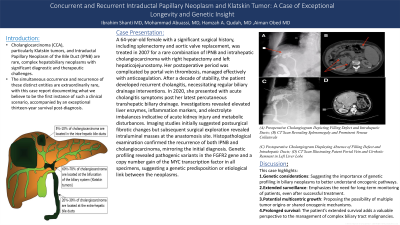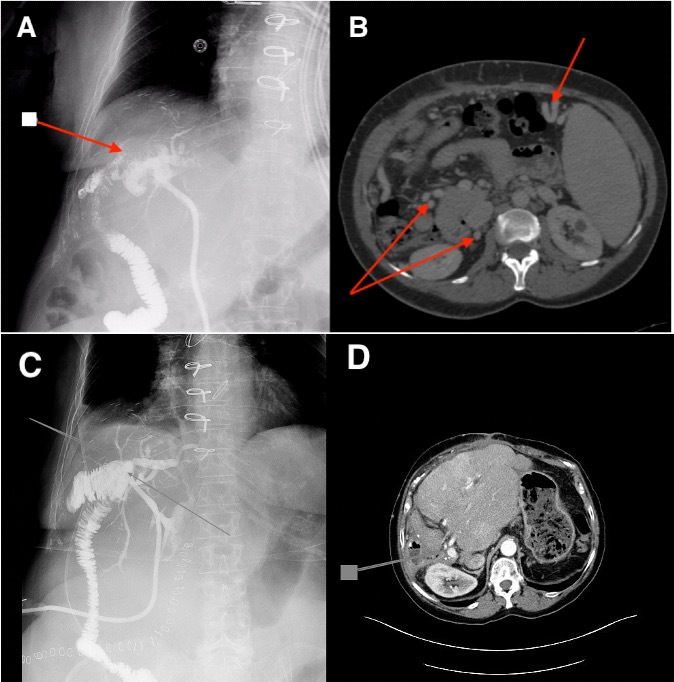Tuesday Poster Session
Category: Biliary/Pancreas
P3617 - Concurrent and Recurrent Intraductal Papillary Neoplasm and Klatskin Tumor: A Case of Exceptional Longevity and Genetic Insight
Tuesday, October 29, 2024
10:30 AM - 4:00 PM ET
Location: Exhibit Hall E

Has Audio

Ibrahim Shanti, MD
Marshall University Joan C. Edwards School of Medicine
huntington, WV
Presenting Author(s)
Mohammad Abuassi, MD1, Ibrahim Shanti, MD2, Hamzah A. Qudah, MD3, Aiman Obed, MD, PhD4
1University of Central Florida, HCA Healthcare GME, Gainesville, FL; 2Marshall University Joan C. Edwards School of Medicine, Huntington, WV; 3HCA Florida Capital Hospital, Tallahasse, FL; 4Jordan Hospital, Amman, 'Amman, Jordan
Introduction: Cholangiocarcinoma (CCA), particularly Klatskin tumors, and Intraductal Papillary Neoplasm of the Bile Duct (IPNB) are rare, complex hepatobiliary neoplasms with significant diagnostic and therapeutic challenges. The simultaneous occurrence and recurrence of these distinct entities are extraordinarily rare, with this case report documenting what we believe to be the first instance of such a clinical scenario, accompanied by an exceptional thirteen-year survival post-diagnosis.
Case Description/Methods: A 64-year-old female with a significant surgical history, including splenectomy and aortic valve replacement, was treated in 2007 for a rare combination of IPNB and intrahepatic cholangiocarcinoma with right hepatectomy and left hepaticojejunostomy. Her postoperative period was complicated by portal vein thrombosis, managed effectively with anticoagulation. After a decade of stability, the patient developed recurrent cholangitis, necessitating regular biliary drainage interventions. In 2020, she presented with acute cholangitis symptoms post her latest percutaneous transhepatic biliary drainage. Investigations revealed elevated liver enzymes, inflammation markers, and electrolyte imbalances indicative of acute kidney injury and metabolic disturbances. Imaging studies initially suggested postsurgical fibrotic changes but subsequent surgical exploration revealed intraluminal masses at the anastomosis site. Histopathological examination confirmed the recurrence of both IPNB and cholangiocarcinoma, mirroring the initial diagnosis. Genetic profiling revealed pathogenic variants in the FGFR2 gene and a copy number gain of the MYC transcription factor in all specimens, suggesting a genetic predisposition or etiological link between the neoplasms.
Discussion: The coexistence and subsequent recurrence of IPNB and Klatskin tumor within the same patient, along with the prolonged survival, presents a unique case that contributes to the evolving narrative of biliary tract malignancies. This case underscores the importance of considering genetic profiles in biliary neoplasms, advocating for extended surveillance and suggesting a potential for multicentric growth or common oncogenic pathways. Such rare instances enrich our understanding and approach to managing complex biliary pathologies, emphasizing the need for long-term follow-up even after successful initial treatment.

Disclosures:
Mohammad Abuassi, MD1, Ibrahim Shanti, MD2, Hamzah A. Qudah, MD3, Aiman Obed, MD, PhD4. P3617 - Concurrent and Recurrent Intraductal Papillary Neoplasm and Klatskin Tumor: A Case of Exceptional Longevity and Genetic Insight, ACG 2024 Annual Scientific Meeting Abstracts. Philadelphia, PA: American College of Gastroenterology.
1University of Central Florida, HCA Healthcare GME, Gainesville, FL; 2Marshall University Joan C. Edwards School of Medicine, Huntington, WV; 3HCA Florida Capital Hospital, Tallahasse, FL; 4Jordan Hospital, Amman, 'Amman, Jordan
Introduction: Cholangiocarcinoma (CCA), particularly Klatskin tumors, and Intraductal Papillary Neoplasm of the Bile Duct (IPNB) are rare, complex hepatobiliary neoplasms with significant diagnostic and therapeutic challenges. The simultaneous occurrence and recurrence of these distinct entities are extraordinarily rare, with this case report documenting what we believe to be the first instance of such a clinical scenario, accompanied by an exceptional thirteen-year survival post-diagnosis.
Case Description/Methods: A 64-year-old female with a significant surgical history, including splenectomy and aortic valve replacement, was treated in 2007 for a rare combination of IPNB and intrahepatic cholangiocarcinoma with right hepatectomy and left hepaticojejunostomy. Her postoperative period was complicated by portal vein thrombosis, managed effectively with anticoagulation. After a decade of stability, the patient developed recurrent cholangitis, necessitating regular biliary drainage interventions. In 2020, she presented with acute cholangitis symptoms post her latest percutaneous transhepatic biliary drainage. Investigations revealed elevated liver enzymes, inflammation markers, and electrolyte imbalances indicative of acute kidney injury and metabolic disturbances. Imaging studies initially suggested postsurgical fibrotic changes but subsequent surgical exploration revealed intraluminal masses at the anastomosis site. Histopathological examination confirmed the recurrence of both IPNB and cholangiocarcinoma, mirroring the initial diagnosis. Genetic profiling revealed pathogenic variants in the FGFR2 gene and a copy number gain of the MYC transcription factor in all specimens, suggesting a genetic predisposition or etiological link between the neoplasms.
Discussion: The coexistence and subsequent recurrence of IPNB and Klatskin tumor within the same patient, along with the prolonged survival, presents a unique case that contributes to the evolving narrative of biliary tract malignancies. This case underscores the importance of considering genetic profiles in biliary neoplasms, advocating for extended surveillance and suggesting a potential for multicentric growth or common oncogenic pathways. Such rare instances enrich our understanding and approach to managing complex biliary pathologies, emphasizing the need for long-term follow-up even after successful initial treatment.

Figure: (A) Preoperative Cholangiogram Depicting Filling Defect and Intrahepatic Ducts; (B) CT Scan Revealing Splenomegaly and Prominent Venous Collaterals (C) Postoperative Cholangiogram Displaying Absence of Filling Defect and Intrahepatic Ducts; (D) CT Scan Illustrating Patent Portal Vein and Cirrhotic Remnant in Left Liver Lobe
Disclosures:
Mohammad Abuassi indicated no relevant financial relationships.
Ibrahim Shanti indicated no relevant financial relationships.
Hamzah Qudah indicated no relevant financial relationships.
Aiman Obed indicated no relevant financial relationships.
Mohammad Abuassi, MD1, Ibrahim Shanti, MD2, Hamzah A. Qudah, MD3, Aiman Obed, MD, PhD4. P3617 - Concurrent and Recurrent Intraductal Papillary Neoplasm and Klatskin Tumor: A Case of Exceptional Longevity and Genetic Insight, ACG 2024 Annual Scientific Meeting Abstracts. Philadelphia, PA: American College of Gastroenterology.

